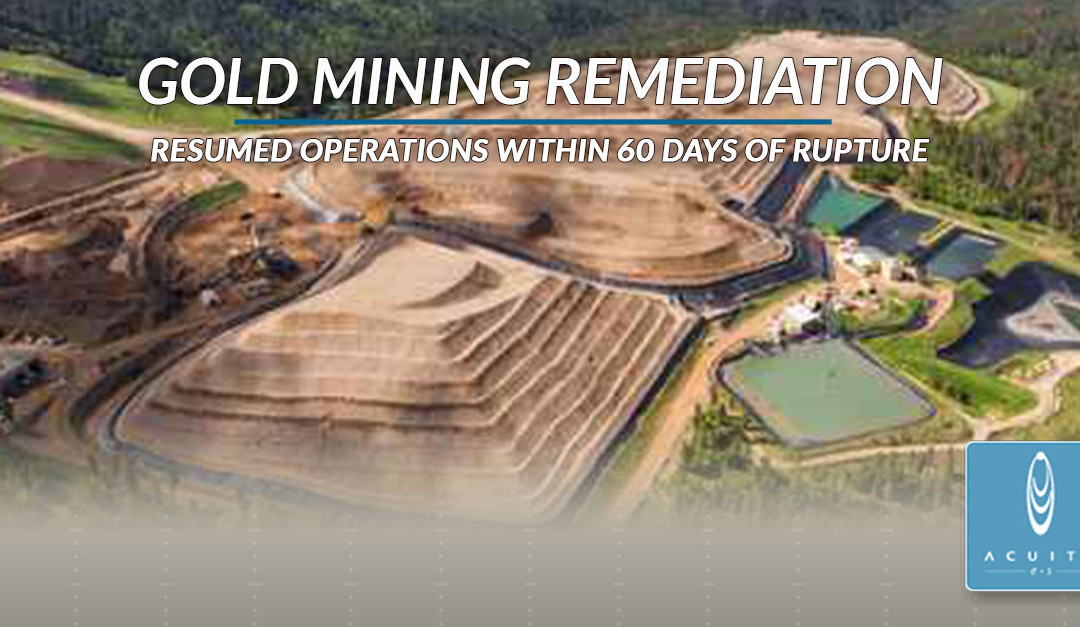With the recent release of contaminated water from an inactive gold mine in Colorado, many people are wondering how the spill will be cleaned up. The process in Colorado will take some time, but examples do exist of both effective and efficient remediation techniques for mining related wastes.
The following is an example of how Jim Rouse, Principal Geohydrologist at Acuity Environmental Solutions, helped resolve a situation related to a cyanide heap-leach mining facility in South Dakota.
On the 60th day after the pipeline rupture, all monitoring wells had no detectable Weak Acid Dissociable (WAD) or free cyanide, which meant the mine was able to resume operations.
This summary is referred to as: In-Situ remediation of cyanide groundwater contamination.
BACKGROUND
The rupture of a pipeline at a cyanide heap-leach facility in the Black Hills of South Dakota resulted in the release of a cyanide-bearing solution which infiltrated into an alluvial aquifer along a valley overlying the recharge zone of the main regional limestone aquifer in the Great Plains east of the Black Hills. Sampling of monitoring wells detected p to 80 mg/L of WAD cyanide, causing the state pollution control agency to order cessation of additional activities at the mine until the contamination was remediated.
The mine immediately called Mr. Jim V. Rouse, currently Principal Geohydrologist with Acuity Environmental Solutions, and requested that he design and install a system including all known technologies, to achieve the most time-effective remediation of the cyanide contamination.
AVAILABLE TECHNOLOGIES
Cyanide is a highly reactive ion, consisting of a high-energy bond of carbon and nitrogen. It is utilized in gold mining due to the ability of the cyanide ion to dissolve gold and form a stable complex with gold, as well as many other metals such as copper, cobalt and iron. Destruction of cyanide is commonly achieved by a variety of techniques, including:
- Chemical oxidation
- Biodegradation by various bacteria capable of using the ion
- Ultraviolet degradation, and
- Volatilization
In the interest of time, it was decided to use all four technologies for the in-situ remediation of the cyanide in the ground water.
REMEDIAL SYSTEM COMPONENTS AND OPERATION
Because of the high gradient and permeability in the alluvial valley, the contamination was rapidly migrating down the valley. Therefore expedient field design and construction demanded that the system be installed within a day of the pipeline rupture.
Two trenches were excavated through the alluvium just beyond the toe of the cyanide plume.
- The downstream face of the lower trench was draped with a membrane of plastic sheeting, a perforated pipe was placed in the bottom of the trench and connected to a vertical riser, and the trench backfilled with cobble rock.
- The upstream trench was left open to allow addition of reagents, including the chemical oxidant hydrogen peroxide, which also served as a source of dissolved oxygen. Phosphate fertilizer was spread across the area of the spill.
A RainbirdTM sprinkler irrigation system was set up to spray water recovered from the downgradient trench across the area of the spill, thereby achieving volatilization and UV degradation of the cyanide in the spray. Infiltrating water from the spray dissolved the phosphate fertilizer and carried it into the ground water, thus serving as needed nutrient to the bacterial utilizing the cyanide for the carbon, nitrogen and energy provided by the cyanide contamination.
The system was operated during the daylight hours to take advantage of the UV degradation during the spray. The pump in the lower trench essentially dewatered the water stored behind the plastic sheet dam each day, (with that portion of the water not evaporated stored in soil moisture) which percolated to the saturated portion of the alluvium and then migrated to the sheet dam overnight. Meanwhile, bacterial degradation and chemical oxidation degraded the cyanide in the saturated portion of the alluvium.
RESULTS
Since the cyanide had to be eliminated before the mine was allowed to resume operation, all available technologies were utilized, in concert, to achieve the desired goal.
- Bacterial counts increased due to the addition of phosphate and oxygen, and the addition of hydrogen peroxide increased the oxidation/reduction potential.
- Monitoring showed a sharp decline from the initial peak concentration of 80 mg/L.
On the 60th day after the pipeline rupture, all monitoring wells had no detectable WAD or free cyanide, which meant the mine was able to resume operations. Declines in other cyanide complexes continued to occur. However, no effort was made to quantify which of the cyanide destruction technique was most effective.

